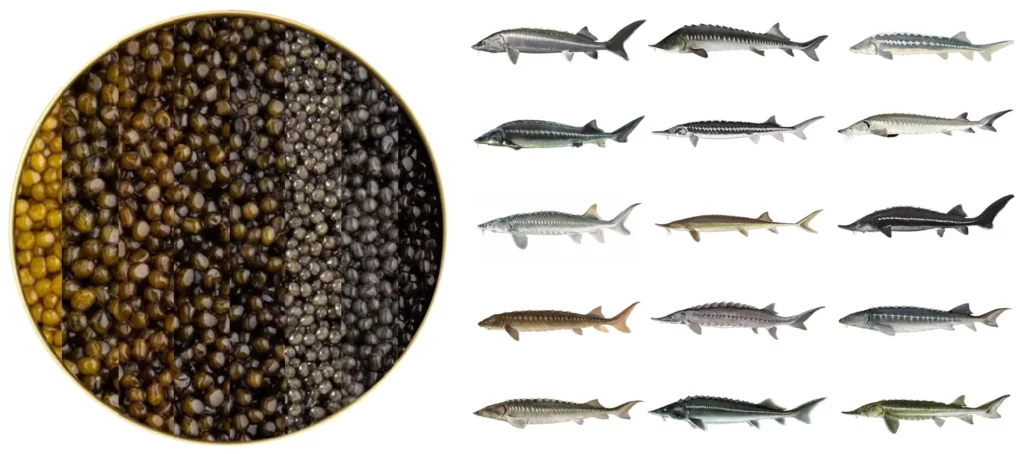Caviar typically comes from sturgeon fish.
Know More About: what fish does caviar come from
Caviar: Delightful Pearl of the Sea
Picture a luxurious plate of delectable treats, each miniature pearl-like sphere glistening in the light. Caviar, often associated with opulence and finesse, is indeed one of the world’s most prized culinary treasures. Derived from the roe of various fish species, caviar tantalizes taste buds and casts an enchanting spell on even the most discerning palates.
The history of caviar traces back thousands of years, originating from the Caspian and Black Seas. Although many fish species produce roe, only a select few are sought after for the creation of caviar. The most renowned caviar comes from two distinct fish families: sturgeons and paddlefish.
Sturgeons, the aristocrats of the caviar world, grace the oceans and rivers with their elegant presence. These ancient creatures, some of the oldest fish species on Earth, have been swimming in our waters for around 250 million years. Sturgeon roe, which produces the highly coveted Beluga and Osetra caviar, is considered the pinnacle of luxury.
The Beluga sturgeon, a true titan of the fish world, captures our imagination and captivates our taste buds. Named after its massive size and robust physique, the Beluga can grow to astonishing lengths of up to 20 feet. Its eggs, renowned for their generous size and lustrous grayish-black color, offer a sensory experience like no other, delivering a buttery and rich flavor that melts in the mouth. Beluga caviar embodies luxury on a grand scale.
Osetra, another esteemed member of the sturgeon family, provides a regal alternative to Beluga caviar. With an alluring dark brown to golden hue and a slightly nutty flavor, Osetra caviar satisfies even the most refined palates. This exquisite delicacy is highly sought after for its exceptional quality, making it a fixture in elegant dining establishments worldwide.
Not to be overshadowed by the sturgeons, paddlefish, distant cousins of the sturgeons, bestow their own unique gift upon the culinary realm – American paddlefish caviar. Found in the Mississippi and Missouri River basins, these majestic creatures glide through the water with grace. The resulting caviar, a delightful and less expensive alternative to pure sturgeon caviar, pleases gourmands across the globe.
Paddlefish roe, with its small to medium-sized eggs and a captivating range of hues from light gray to dark charcoal, delivers a burst of flavor that is both fresh and buttery. Its subtle nuttiness is accompanied by a slight mineral undertone, creating a perfect harmony for the palate to savor. Often referred to as the “splash of the American West,” paddlefish caviar encapsulates the spirit of indulgence in a changing world.
As caviar has become increasingly popular, sustainable farming practices have emerged to protect vulnerable fish populations. Aquaculture operations have elevated the art and science of caviar production, ensuring that sturgeon and paddlefish thrive in safe environments while providing a sustainable and ethical source of this delicacy.
In conclusion, the world of caviar is deeply intertwined with the majestic fish that produce it. From the prehistoric sturgeons to the graceful paddlefish, these guardian species represent an illustrious heritage of elegance and renowned flavors. Whether it be the grandeur of Beluga and Osetra caviar or the more affordable paddlefish alternative, these tiny pearls enchant our senses, inviting us to embark on a culinary journey that marries tradition and innovation. So next time you savor a spoonful of caviar, remember the fish that bestowed upon us this exquisite gift from the sea.
Key Takeaways from what fish does caviar come from
Caviar comes from the eggs of various species of fish, primarily sturgeon. Sturgeon is a prehistoric fish found in freshwater bodies such as rivers and lakes, and its rich, flavorful roe has been prized as a delicacy for centuries. Beluga, Ossetra, and Sevruga are the most sought-after types of caviar, originating from different sturgeon species. However, due to overfishing and environmental concerns, wild sturgeon populations have declined significantly, leading to increased conservation efforts and caviar farming. Today, caviar can also be sourced from other fish species like salmon, trout, and even non-sturgeon species, providing more options for caviar enthusiasts.
FAQs on what fish does caviar come from
1. What fish does caviar come from?
Caviar typically comes from sturgeon fish, particularly species like Beluga, Osetra, and Sevruga.
2. Can caviar come from any other fish?
Although sturgeon is the most common source for caviar, it can also come from other fish such as paddlefish, salmon, trout, and whitefish. However, these are commonly referred to as “fish roe” rather than caviar.
3. How is caviar obtained from fish?
Caviar is obtained by gently massaging the ripe ovaries of female sturgeon fish to extract the eggs. The fish are not harmed during this process, and they can produce caviar multiple times in their lifetime.
4. Is caviar expensive because it comes from a specific fish?
Yes, caviar is considered a luxury delicacy partly because it comes from sturgeon fish, which are rare and take a long time to mature. Additionally, the meticulous and time-consuming process of extracting the eggs contributes to its high cost.
5. Are there different types of caviar based on the fish it comes from?
Yes, depending on the species of sturgeon fish, caviar can have different characteristics, flavors, and prices. For example, Beluga caviar is known for its large, delicate eggs and buttery flavor, while Osetra caviar is smaller but distinctively nutty-tasting.
6. Can caviar be harvested sustainably from sturgeon fish?
Yes, sustainable caviar production practices have been developed. Some caviar farms focus on breeding sturgeon in controlled environments, ensuring their well-being while also protecting wild sturgeon populations.
7. How long does it take for sturgeon fish to produce caviar?
Sturgeon fish take several years to mature before they are ready to produce eggs. It can typically take around 8-20 years, depending on the species, for sturgeon to reach the desired age for caviar production.
8. Why is caviar often served chilled or on ice?
Caviar is commonly served chilled or on ice to maintain its freshness and enhance its flavor. Colder temperatures help to preserve the delicate taste and texture of the eggs.
9. Can caviar be eaten raw?
Yes, caviar is often enjoyed in its raw form to savor its natural flavors. It is a popular choice for appetizers, garnishes, or as an accompaniment to certain dishes.
10. How long can caviar be stored?
Unopened caviar can be stored in a refrigerator for a few weeks, while opened caviar should be consumed within a few days. It is essential to keep it in a sealed container to prevent any absorption of odors and maintain its quality.

